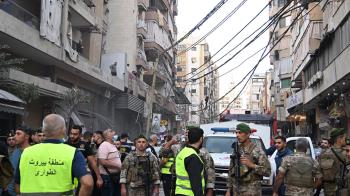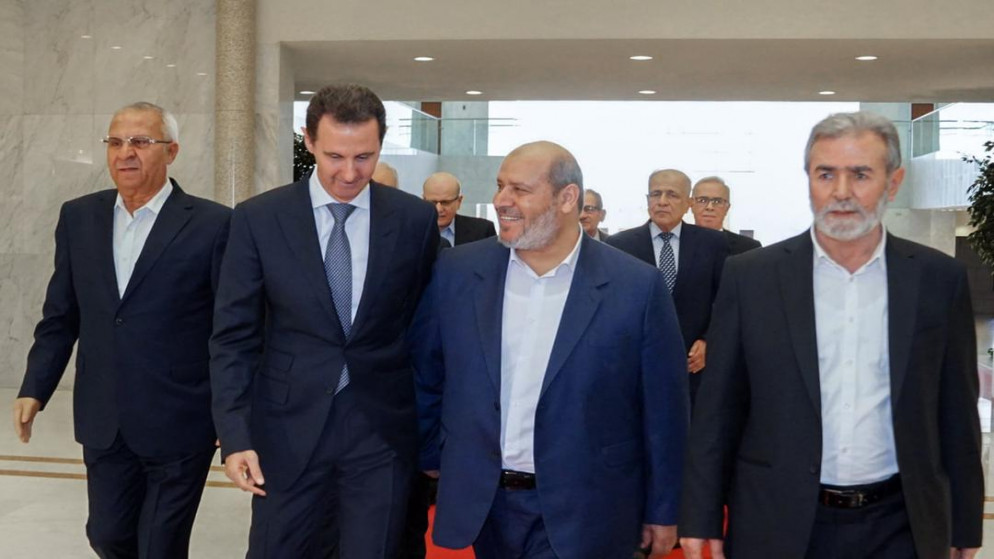Alwaght- Amid broadening insecurity and clashes between the Israelis and the Palestinian groups in various parts of the occupied West Bank and only a week after Naqab 2 summit in Jordan, a delegation of Hamas in an intriguing move visited Damascus.
In recent months, the relationship between Syrian government and Hamas witnessed a considerable development towards rebuilding and restoration of the past unity and cooperation. After a meeting between a high-ranking Hamas delegation and President Bashar al-Assad of Syria in October last year, Hamas spokesman Hazem Ghasem commented on the arrangements to improve relations, saying: “Continuous effort to restore relations started with the mediation of the regional parties, especially members of Axis of Resistance, and then messages were exchanged until we reached this meeting.”
After start of the Syrian crisis a decade ago, Hamas-Damascus relations grew strained. Hamas leaders led by Khaled Masha’al, then chief of Hamas Political Office in Damascus, in February 2012 left Syria which was their seat for several decades. The movement closed down all of its offices and ceased all of its activities in the crisis-hit country.
However, in 2017, Hamas announced its split from the Muslim Brotherhood (MB), which analysts interpreted as a prelude to a return to Syria by demonstrating political independence and distance from Turkey and Qatar, both supporting MB-affiliated governments in the region. The MB has been banned in Syria since the 1980s, and the group was one of the most prominent elements of the armed opposition in Syria after the crisis erupted. On the Syrian side, such signals were sent out by the Syrian government before the full restoration of relations. Al-Assad, in a meeting with a number of Palestinian resistance leaders in May 2021 after the battle of Hamas’s Operation Sword of Al-Quds against the Israeli regime said, “Greetings to all the resistance fighters in Gaza. Syria’s doors are open to all Palestinian resistance factions, and Syria is politically and militarily at the heart of the Axis of Resistance against the Israeli occupation.”
But beside the ethical commitment and principal policy of the government of al-Assad, what eventually accelerated improvement of Damascus-Hamas ties was the regional developments deriving from Arab countries and Turkey’s movement towards normalization with the Israeli regime, something reminded Hamas of the need to tighten its strategic bonds with Resistance camp members.
So, part of the goal behind recent visit to Damascus has to do with completing the past cooperation cycles with Syrian government which can lead to reopening political office in the Syrian capital.
During this trip, Talal Naji, the secretary-general of Popular Front for the Palestine Liberation, said: “The presence of the members of the Hamas political office in Damascus indicates the return of relations with Syria to what it was before.”
The show of care about restoration of past bonds is not disconnected from the day’s developments in Syria and Palestine, and actually Hamas delegation’s visit carries a message to the hardline Israeli cabinet that is taking reckless steps towards a new conflict in the region.
It has been over 10 days since an Israeli airstrike on Kafr Sousa neighborhood of Damascus killed a number of Syrians, including an army officer. Although Syrian government has so far managed to reduce the rate of success of the Israeli air raids using its air defenses, this reality is undeniable that Syria’s internal crisis led to Damascus losing a majority of its balance-making cards against the Israeli regime. One of the major cards creating a balance of terror with Tel Aviv is alliance with the Palestinian resistance, a card Damascus is fast restoring. Following recent Israeli attack, some Islamic Jihad sources said that the target was a meeting of resistance leaders in Damascus. This report means that the Syrian government is seeking a bigger role in the West Bank developments.
Ziyad al-Nakhalah, the chief of the Islamic Jihad Movement, earlier talked about the continuation of the Syrian government’s support for the resistance, saying: “The first anti-tank missile that was fired by the Quds Brigades at an Israeli armored vehicle in the Gaza Strip during the battle of Sword of Al-Quds was procured with the support of Syria and reached Gaza through the [Syrian] port of Latakia.
One of the objectives of the Damascus visit is said to be participation in an expected meeting of Palestinian resistance factions. Khalil al-Haya, the head of Hamas Office of Arab and Islamic Relations, held that the goal behind meeting of the Palestinian groups is unity of national fronts to counter the Israeli crimes in the shadow of rule of “fascist government of the Zionist regime” that is fanning the flames of conflict and commits crimes against the Palestinians.
“Hamas condemns all the meetings and summits whose target is the Palestine resistance, either they are held in Aqaba or elsewhere,” said al-Haya.
Addressing conditions of Palestinian victims of Syria earthquake
Beside anti-Israeli goals, another goal of the visit appears to be the Palestinians hit by earthquake in Syria who need aids to ease their suffering. Immediately after the February 6 powerful earthquake, Hamas leader Ismail Haniyeh published a message of solidarity with Syria, saying that Hamas was ready to help the victims.
Figures suggest that Palestinians were also among earthquake victims. Ahmad al-Deek, the advisor to Palestinian foreign minister, said that at least 51 Palestinians in Latakia’s Al-Raml and Aleppo’s Al-Nayrab refugee camps were killed.
According to figures published by international aid agency in Palestine, UNRWA, currently 438,000 Palestinian refugees live in Syria, with a majority of them living under the poverty line, namely with a daily income of less than two dollars for each person, and 40 percent of them are in long-term state of displacement due to constant conflict and destruction of their homes. This means that the Syrian government, with regard to Western sanctions hampering international aids to the country, lacks adequate capability to settle problems of earthquake victims, and the latter naturally expect help from the Palestinian Authority and Hamas.



























